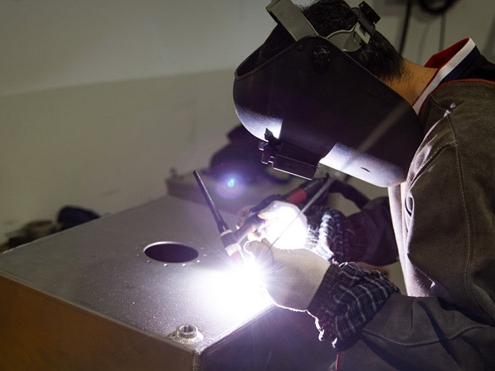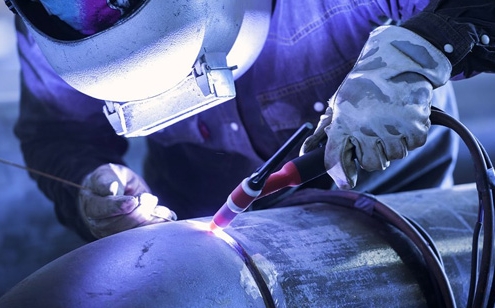Welding vs Riveting: A Comparison Guide
In any project involving metalwork, the right joining technique is critical. Using an unsuitable method could lead to structural failure, costly repairs, and safety risks.
Welding and riveting are essential joining methods in metalwork, each offering unique benefits. Welding fuses metals, creating a seamless, strong bond ideal for heavy-duty uses, while riveting joins parts with metal pins, allowing flexibility. Riveting suits thin metals and load distribution, making it ideal for aerospace and construction.
Both techniques have their place, but understanding their differences will help you decide on the best method for your project.
What is Riveting?
Riveting is a permanent joining process where a rivet, a metal pin or bolt, is inserted through aligned holes in metal sheets or parts, then deformed on one end to hold the pieces together. Commonly used in shipbuilding, construction, and even metal jewelry, riveting provides robust, reliable connections for materials that might otherwise be difficult to weld.
Types of Riveted Joints
- Lap Joint
A lap joint is the simplest riveted joint, where two overlapping metal sheets are joined with rivets. It’s easy to assemble, making it common in low-stress applications. However, the overlapping area can create an uneven surface, leading to potential stress points. - Butt Joint with Cover Plates
In a butt joint, two aligned metal sheets are joined edge-to-edge and reinforced with cover plates on one or both sides. This type provides a flush surface and distributes stress better than a lap joint, making it suitable for higher-load applications. - Double-Row and Multi-Row Riveted Joints
These joints increase strength by arranging rivets in multiple rows, which spreads the load more effectively across the joint. Double or multi-row configurations are used in high-stress applications where increased durability is required. - Flush Rivet Joint
Flush rivet joints create a smooth, even surface by sinking the rivet heads into the material. This type of joint is often used in aircraft construction, as the smooth surface reduces drag and enhances aerodynamic efficiency.
Pros and Cons of Riveting
Pros:
Simple Installation: Riveting doesn’t require extensive equipment and is relatively straightforward to perform.
Flexibility: Allows for slight movement, making it suitable for applications that undergo stress or vibration, like in aircraft.
Maintenance-Friendly: Riveted parts can often be disassembled and reassembled, facilitating repairs and replacements.
Cons:
Added Weight: Rivets can add significant weight, especially in structures requiring multiple rivets.
Stress Concentration: Rivets create holes in materials, potentially causing stress concentration points that weaken the structure.
Lower Strength: Riveted joints may be less strong than welded joints, especially for high-stress applications.
What is Welding?
Welding involves fusing two metal pieces through intense heat and pressure. In metalwork, welding produces a highly durable bond, often stronger than the original metal. This method is preferred in applications where seamless, strong joints are essential, such as in automotive, aerospace, and industrial machinery.

Differences Between Welding and Riveting
Welding and riveting, the key differences between these two processes can determine whether they are suitable for a particular product. Let’s take a deeper look at these differences.
Joining Method:
Welding creates a bond by melting and fusing materials at the molecular level, resulting in a seamless joint. This process is effective for creating solid, uninterrupted structures but requires skilled handling and specific equipment.
In contrast, riveting joins materials mechanically, using metal fasteners that pass through aligned holes and riveting does not melt the materials.
Strength and Rigidity:
Welded joints offer exceptional strength and rigidity, making them suitable for high-stress applications where a continuous bond is essential. However, welding can create a more brittle connection that may not handle flexibility well. Riveting,
On the other hand, allows for slight flexibility and better load distribution across the joint, especially useful in applications with vibration or stress cycles, though it may lack the same strength as welded connections.
Material Compatibility:
Welding is best for joining similar metals because different metals have varying thermal properties, making the bond weak or prone to corrosion. Riveting bypasses these challenges by using fasteners, allowing dissimilar materials to be joined without the risk of thermal or chemical incompatibility. This advantage makes riveting more versatile for projects involving different metals or even other materials.
Heat and Distortion:
Welding involves intense heat, which can distort or weaken thin or heat-sensitive materials. This can be a drawback in applications where material integrity is critical, such as in precision manufacturing. Riveting, however, avoids heat entirely, making it suitable for projects that require maintaining material structure and integrity, as seen in aerospace and certain automotive applications.
Is Welding Better Than Riveting?

Welding and riveting each have distinct advantages tailored to specific applications. Welding is particularly effective in structural applications where strength and rigidity are paramount. It forms seamless, continuous joints that can withstand high stress and load, making it ideal for heavy machinery, construction, and critical infrastructure projects.
On the other hand, riveting shines in scenarios that require detachable or lightweight connections. This method allows for flexibility and ease of disassembly, making it perfect for applications like aerospace, automotive, and construction where components may need to be serviced or replaced. Riveting is advantageous when working with different materials, as it does not involve heat that can alter material properties. Ultimately, assessing your project’s specific needs—such as load requirements, material compatibility, and maintenance considerations—will help determine whether welding or riveting is the superior method for your situation.
How Strong are Rivets?
Rivets provide solid, reliable joints that withstand considerable forces. In high-stress environments, such as aerospace and heavy-duty construction, rivets offer a mechanical fastening solution that can distribute stress more evenly across the joint.
Welded joints are sometimes susceptible to cracks and failures under extreme conditions. But, rivets can often maintain their integrity and strength, making them a preferred choice for applications requiring high durability and reliability.
In Conclusion
Welding and riveting differ significantly in that welding involves fusing two pieces of metal together using heat, creating a strong, seamless joint, while riveting joins metals by inserting a rivet through pre-drilled holes and deforming its ends to secure the pieces, resulting in a mechanical joint.
Both welding and riveting play vital roles in joining metals, but the best choice depends on your project’s specific needs.
Frequently Asked Questions About Welding vs Riveting
Why Shouldn’t two Different Metals be Welded Together?
When welding, it is often difficult to weld two different metals as the joint is likely to be weak. Now, why is that? Because, generally, if the metals aren’t alike, their properties are not alike. They have different melting points, different rates of thermal expansion, and different natures when it comes to chemical interaction. All of these differences create stress between the two metals upon heating and cooling, causing the joint to be very weak. Sometimes it also causes cracks or distortion in the resulting joint. When two metals that differ in nature have a chemical reaction, the product of that reaction is something that is generally very weak and brittle—causing a weak weld joint.
Can Different Metals be Welded?
Yes, but the process often involves using some very advanced techniques, such as explosion welding. These techniques may work, but they are typically very expensive and would not be considered by most people. Most people would choose an alternative method to mechanically join them. It would be a lot safer to rivet them together or use one of several alternative bonding agents.
Is TIG Welding a Good Choice for Stainless Steel?
Yes, it is an excellent process to use on stainless steel. It makes a very nice weld and if done properly, does not contaminate the stainless. The tungsten electrode and the inert gas used for shielding are inert with respect to stainless steel. Therefore, current flow is not an issue from a corrosion standpoint. So yes, stainless steel can be TIG welded using the proper procedures. As a matter of fact, TIG welding is an excellent method for welding stainless steel. However, it does require skill on the part of the welder to make sure the weld is formed properly so it doesn’t become porous and that the stainless isn’t contaminated as a result of the process.



